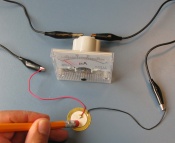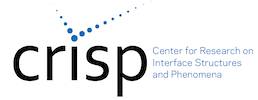Our kits are currently being reviewed and updated by a team of collaborative, innovative and interdisciplinary educators who wish to enhance the educational opportunities for students. These dedicated teachers are members of CRISP Collaborative Science for All (CCSA) as well as local educators.
Click to see the SCSU CRISP Module Template used by CCSA for improving and updating the CRISP demos and kits. Each kit page offers a CRISP developed teacher module and CRISP aligned standards (both NGSS and CCSS)
Kit Request form

Piezoelectric materials can turn mechanical stress into electricity, and electricity into mechanical vibrations. Quartz is an example of a naturally occurring piezoelectric crystal. Quartz crystals are made of silicon and oxygen atoms in a repeating pattern. In quartz, the silicon atoms have a positive charge and oxygen atoms have a negative charge. Normally, when the crystal is not under any external stress, the charges are dispersed evenly in the molecules throughout the crystal. But when quartz is stretched or squeezed, the arrangement of the atoms changes slightly. This change causes negative charges to build up on one side and positive charges to build up on the opposite side. When you make a circuit that connects one end of the crystal to the other you can use this potential difference to produce current. The more you squeeze the crystal the stronger the electric current will be. Conversely, sending an electric current though the crystal changes its shape.
Adapted from NanoDays Toolkits originally created for NISEnet via the NanoDays project
This material is based upon work supported by the National Science Foundation Award Numbers 0532536 and 0940143. Any opinions, findings, and conclusions expressed in this material are those of the authors and do not necessarily reflect the views of the National Science Foundation.
Subject(s):
Piezoelectric, Electricity, Structure-Properties relationships
Objectives:
Students will understand that the way a material behaves on the macroscale is affected by its structure on the nanoscale and that nanotechnology takes advantage of special properties at the nanoscale to create new materials.
Materials in this kit:
- Piezoelectric disc with leads
- Ammeter
- Alligator clips
- Pencil with eraser
- Piezoelectric buzzer with leads
- Battery holder for 2 AA batteries
- 2 AA batteries
- Piezoelectric effect image sheet
Suggestions for the Teacher:
The piezoelectric disk is somewhat fragile so we recommend tapping on it with a pencil eraser, but students can use their fingers as well. Do not use large force on the disc
If you find the buzzer to be too loud, you can place a piece of transparent tape over the hole. This will dampen the sound slightly.
Safety:
Additional Resources:
Electric Squeeze Teacher Module
Electric Squeeze CRISP aligned standards
Electric-squeeze Guide from NanoDays
Electric-squeeze-image-sheet from NanoDays
Electric-squeeze-multimeter-instructions From NanoDays
NanoDays Electric Squeeze page
STEM Careers:
Electrical Engineer
Materials Scientist
Researcher
Electrician
Engineer
Computer hardware Engineer
Electrical Engineering Technologists
Electrical and Electronic Engineering Technicians
Electro-Mechanical Technicians
Nanosystems Engineers
Standards:
4-PS3-2.
- Make observations to provide evidence that energy can be transferred from place to place by sound, light, heat, and electric currents.
MS-PS1-1 Matter and its Interactions
- Develop models to describe the atomic composition of simple molecules and extended structures.
HS-PS1-3 Matter and its Interactions
- Plan and conduct an investigation to gather evidence to compare the structure of substances at the bulk scale to infer the strength of electrical forces between particles.
PS3.A: Definitions of Energy
- Energy can be moved from place to place by moving objects or through sound, light, or electric currents.
PS3.B: Conservation of Energy and Energy Transfer
- Energy is present whenever there are moving objects, sound, light, or heat. When objects collide, energy can be transferred from one object to another, thereby changing their motion. In such collisions, some energy is typically also transferred to the surrounding air; as a result, the air gets heated and sound is produced.
- Energy can also be transferred from place to place by electric currents, which can then be used locally to produce motion, sound, heat, or light. The currents may have been produced to begin with by transforming the energy of motion into electrical energy.
PS1.A: Structure and Properties of Matter
- Substances are made from different types of atoms, which combine with one another in various ways. Atoms form molecules that range in size from two to thousands of atoms.
- Solids may be formed from molecules, or they may be extended structures with repeating subunits (e.g., crystals).
HS-PS1.A: Structure and Properties of Matter
- The structure and interactions of matter at the bulk scale are determined by electrical forces within and between atoms.
CC 5 - Energy and Matter
- Energy can be transferred in various ways and between objects.
CC 3 - Scale, Proportion, and Quantity
- Time, space, and energy phenomena can be observed at various scales using models to study systems that are too large or too small.
HS CC1 - Patterns
- Different patterns may be observed at each of the scales at which a system is studied and can provide evidence for causality in explanations of phenomena.
SEP 4 - Planning and Carrying out Investigations
- Make observations to produce data to serve as the basis for evidence for an explanation of a phenomenon or test a design solution.
